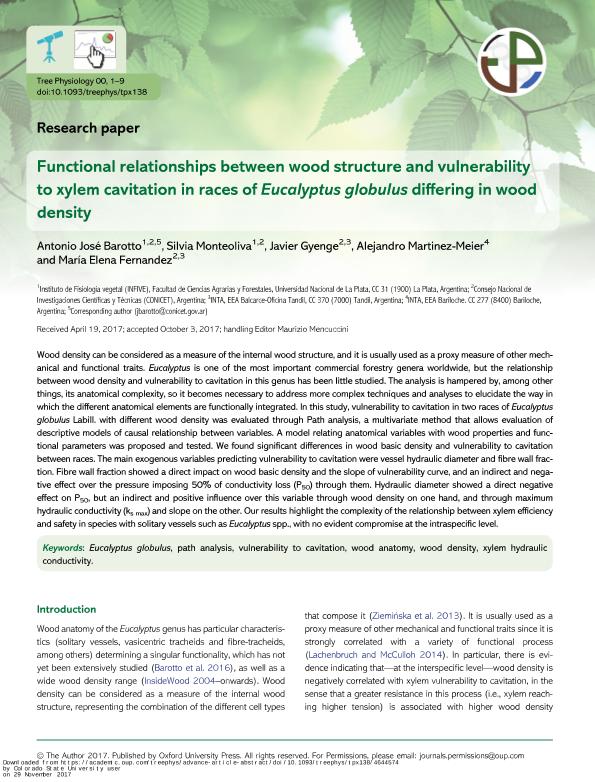Mostrar el registro sencillo del ítem
dc.contributor.author
Barotto, Antonio José

dc.contributor.author
Monteoliva, Silvia Estela

dc.contributor.author
Gyenge, Javier Enrique

dc.contributor.author
Martinez Meier, Alejandro
dc.contributor.author
Fernandez, Maria Elena

dc.date.available
2018-08-14T16:59:07Z
dc.date.issued
2018-02
dc.identifier.citation
Barotto, Antonio José; Monteoliva, Silvia Estela; Gyenge, Javier Enrique; Martinez Meier, Alejandro; Fernandez, Maria Elena; Functional relationships between wood structure and vulnerability to xylem cavitation in races of Eucalyptus globulus differing in wood density; Oxford University Press; Tree Physiology; 38; 2; 2-2018; 243-251
dc.identifier.issn
0829-318X
dc.identifier.uri
http://hdl.handle.net/11336/55388
dc.description.abstract
Wood density can be considered as a measure of the internal wood structure, and it is usually used as a proxy measure of other mechanical and functional traits. Eucalyptus is one of the most important commercial forestry genera worldwide, but the relationship between wood density and vulnerability to cavitation in this genus has been little studied. The analysis is hampered by, among other things, its anatomical complexity, so it becomes necessary to address more complex techniques and analyses to elucidate the way in which the different anatomical elements are functionally integrated. In this study, vulnerability to cavitation in two races of Eucalyptus globulus Labill. with different wood density was evaluated through Path analysis, a multivariate method that allows evaluation of descriptive models of causal relationship between variables. A model relating anatomical variables with wood properties and functional parameters was proposed and tested. We found significant differences in wood basic density and vulnerability to cavitation between races. The main exogenous variables predicting vulnerability to cavitation were vessel hydraulic diameter and fibre wall fraction. Fibre wall fraction showed a direct impact on wood basic density and the slope of vulnerability curve, and an indirect and negative effect over the pressure imposing 50% of conductivity loss (P 50) through them. Hydraulic diameter showed a direct negative effect on P 50, but an indirect and positive influence over this variable through wood density on one hand, and through maximum hydraulic conductivity (k s max) and slope on the other. Our results highlight the complexity of the relationship between xylem efficiency and safety in species with solitary vessels such as Eucalyptus spp., with no evident compromise at the intraspecific level.
dc.format
application/pdf
dc.language.iso
eng
dc.publisher
Oxford University Press

dc.rights
info:eu-repo/semantics/openAccess
dc.rights.uri
https://creativecommons.org/licenses/by-nc-sa/2.5/ar/
dc.subject
Eucalyptus Globulus
dc.subject
Path Analysis
dc.subject
Vulnerability to Cavitation
dc.subject
Wood Anatomy
dc.subject
Wood Density
dc.subject
Xylem Hydraulic Conductivity
dc.subject.classification
Agricultura

dc.subject.classification
Agricultura, Silvicultura y Pesca

dc.subject.classification
CIENCIAS AGRÍCOLAS

dc.title
Functional relationships between wood structure and vulnerability to xylem cavitation in races of Eucalyptus globulus differing in wood density
dc.type
info:eu-repo/semantics/article
dc.type
info:ar-repo/semantics/artículo
dc.type
info:eu-repo/semantics/publishedVersion
dc.date.updated
2018-08-13T17:25:31Z
dc.journal.volume
38
dc.journal.number
2
dc.journal.pagination
243-251
dc.journal.pais
Reino Unido

dc.journal.ciudad
Oxford
dc.description.fil
Fil: Barotto, Antonio José. Consejo Nacional de Investigaciones Científicas y Técnicas. Centro Científico Tecnológico Conicet - La Plata. Instituto de Fisiología Vegetal. Universidad Nacional de La Plata. Facultad de Ciencias Naturales y Museo. Instituto de Fisiología Vegetal; Argentina
dc.description.fil
Fil: Monteoliva, Silvia Estela. Consejo Nacional de Investigaciones Científicas y Técnicas. Centro Científico Tecnológico Conicet - La Plata. Instituto de Fisiología Vegetal. Universidad Nacional de La Plata. Facultad de Ciencias Naturales y Museo. Instituto de Fisiología Vegetal; Argentina
dc.description.fil
Fil: Gyenge, Javier Enrique. Consejo Nacional de Investigaciones Científicas y Técnicas; Argentina. Instituto Nacional de Tecnología Agropecuaria. Centro Regional Buenos Aires Sur. Estación Experimental Agropecuaria Balcarce; Argentina
dc.description.fil
Fil: Martinez Meier, Alejandro. Instituto Nacional de Tecnología Agropecuaria. Centro Regional Patagonia Norte. Estación Experimental Agropecuaria San Carlos de Bariloche. Grupo de Ecología Forestal; Argentina
dc.description.fil
Fil: Fernandez, Maria Elena. Instituto Nacional de Tecnología Agropecuaria. Centro Regional Buenos Aires Sur. Estación Experimental Agropecuaria Balcarce; Argentina. Consejo Nacional de Investigaciones Científicas y Técnicas; Argentina
dc.journal.title
Tree Physiology

dc.relation.alternativeid
info:eu-repo/semantics/altIdentifier/doi/http://dx.doi.org/10.1093/treephys/tpx138
dc.relation.alternativeid
info:eu-repo/semantics/altIdentifier/url/https://academic.oup.com/treephys/article-abstract/38/2/243/4644574
Archivos asociados
